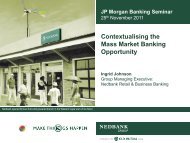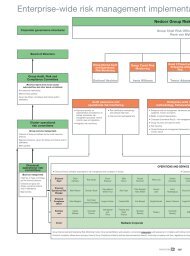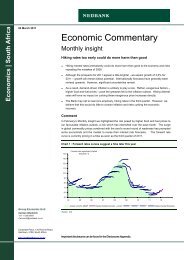Download the PDF (5.4 MB) - Nedbank Group Limited
Download the PDF (5.4 MB) - Nedbank Group Limited
Download the PDF (5.4 MB) - Nedbank Group Limited
You also want an ePaper? Increase the reach of your titles
YUMPU automatically turns print PDFs into web optimized ePapers that Google loves.
270 NEDBANK GROUP <strong>Limited</strong> INTEGRATED REPORT 20101 Principal accounting policies ... continued1.4 Financial instruments ... continuedMeasurement basis of financial instrumentsThere are two bases of measurement:• amortised cost; and• fair value.• Amortised costThe amortised cost of a financial instrument is <strong>the</strong> amount at which<strong>the</strong> financial instrument is measured on initial recognition minusprincipal repayments, plus or minus <strong>the</strong> cumulative amortisationusing <strong>the</strong> effective-interest-rate method of any difference between<strong>the</strong> initial contractual amount and <strong>the</strong> maturity amount, less anycumulative impairment losses.The effective-interest-rate method is a method of calculating <strong>the</strong>amortised cost of a financial instrument and of allocating <strong>the</strong> interestincome and expense over <strong>the</strong> relevant period. The effective interestrate is <strong>the</strong> rate that exactly discounts estimated future cash paymentsor receipts through <strong>the</strong> expected life of <strong>the</strong> financial instrument or,when appropriate, a shorter period, to <strong>the</strong> net carrying amount of<strong>the</strong> financial instrument. When calculating <strong>the</strong> effective interestrate, cashflows are estimated considering all contractual terms of<strong>the</strong> financial instrument, but future credit losses are not considered.The calculation includes all fees and points paid or received betweenparties to <strong>the</strong> contract that are an integral part of <strong>the</strong> effective interestrate, transaction costs, and all o<strong>the</strong>r premiums or discounts.• Fair valueThe fair value of a financial instrument is defined as <strong>the</strong> price atwhich an asset or liability could be exchanged in a current transactionbetween knowledgeable, willing parties, o<strong>the</strong>r than in a forced orliquidation sale.The fair value of instruments that are quoted in an active market isdetermined using quoted prices where <strong>the</strong>y represent those at whichregularly and recently occurring transactions take place.The group uses valuation techniques to establish <strong>the</strong> fair value ofinstruments where quoted prices in active markets are not available.For a detailed discussion of <strong>the</strong> fair value of financial instruments referto Note 6.1: Valuation of financial instruments on pages 284 to 289 of<strong>the</strong> annual financial statements.Impairment of financial assetsThe group assesses at each reporting date whe<strong>the</strong>r <strong>the</strong>re is objectiveevidence that a financial asset or group of financial assets is impaired. Afinancial asset or a group of financial assets is impaired and impairmentlosses are incurred if, and only if, <strong>the</strong>re is objective evidence of impairmentas a result of one or more events that occurred after <strong>the</strong> initial recognitionof <strong>the</strong> asset (a loss event) and that loss event has (or events have) animpact on <strong>the</strong> estimated future cashflows of <strong>the</strong> financial asset or groupof financial assets that can be reliably estimated. Objective evidence thata financial asset or group of assets is impaired includes observable datathat comes to <strong>the</strong> attention of <strong>the</strong> group about <strong>the</strong> following loss events:• significant financial difficulty of <strong>the</strong> issuer or obligor;• a breach of contract, such as a default or delinquency in interest orprincipal payments;• <strong>the</strong> group granting to <strong>the</strong> borrower, for economic or legal reasonsrelating to <strong>the</strong> borrower’s financial difficulty, a concession that <strong>the</strong>group would not o<strong>the</strong>rwise consider;• it becoming probable that <strong>the</strong> borrower will enter bankruptcy or o<strong>the</strong>rfinancial reorganisation;• <strong>the</strong> disappearance of an active market for that financial asset becauseof financial difficulties; or• observable data indicating that <strong>the</strong>re is a measurable decrease in <strong>the</strong>estimated future cashflows from a group of financial assets since <strong>the</strong>initial recognition of those assets, although <strong>the</strong> decrease cannot yet beidentified with <strong>the</strong> individual financial assets in <strong>the</strong> group, including:– adverse changes in <strong>the</strong> payment status of borrowers in <strong>the</strong> group; or– national or local economic conditions that correlate with defaultson <strong>the</strong> assets in <strong>the</strong> group.• Assets carried at amortised costIf <strong>the</strong>re is objective evidence that an impairment loss on loans andreceivables or held-to-maturity financial assets carried at amortisedcost has been incurred, <strong>the</strong> amount of <strong>the</strong> impairment loss is measuredas <strong>the</strong> difference between <strong>the</strong> asset’s carrying amount and <strong>the</strong> presentvalue of estimated future cashflows (excluding future credit losses thathave not been incurred) discounted at <strong>the</strong> financial asset’s originaleffective interest rate. The carrying amount of <strong>the</strong> asset is reducedthrough <strong>the</strong> use of an allowance account and <strong>the</strong> amount of <strong>the</strong> loss isrecognised in profit or loss.The group first assesses whe<strong>the</strong>r <strong>the</strong>re is objective evidence ofimpairment individually for financial assets that are individuallysignificant, and individually or collectively for financial assets that arenot individually significant. If <strong>the</strong> group determines that <strong>the</strong>re is noobjective evidence of impairment for an individually assessed financialasset, whe<strong>the</strong>r significant or not, it includes <strong>the</strong> asset in a group offinancial assets with similar credit risk characteristics and collectivelyassesses <strong>the</strong>m for impairment.If, in a subsequent period, <strong>the</strong> amount of <strong>the</strong> impairment loss decreasesand <strong>the</strong> decrease can be related objectively to an event occurringafter <strong>the</strong> impairment was recognised (such as an improvement in <strong>the</strong>debtor’s credit rating), <strong>the</strong> previously recognised impairment loss isreversed by adjusting <strong>the</strong> allowance account. The reversal may notresult in a carrying amount of <strong>the</strong> financial asset that exceeds what<strong>the</strong> amortised cost would have been had <strong>the</strong> impairment not beenrecognised at <strong>the</strong> date on which <strong>the</strong> impairment is reversed. Theamount of <strong>the</strong> reversal is recognised in profit or loss for <strong>the</strong> period.• Available-for-sale financial assetsWhen a decline in <strong>the</strong> fair value of an available-for-sale financialasset has been recognised directly in equity, in <strong>the</strong> statement ofcomprehensive income, and <strong>the</strong>re is objective evidence that <strong>the</strong> assetis impaired, <strong>the</strong> cumulative loss that has been recognised directlyin equity, in <strong>the</strong> statement of comprehensive income, is removedfrom equity and recognised in profit or loss. The amount of <strong>the</strong>cumulative loss that is removed from equity and recognised in profitor loss is <strong>the</strong> difference between <strong>the</strong> acquisition cost (net of anyprincipal repayment and amortisation) and current fair value, less anyimpairment loss on that financial asset previously recognised in profitor loss. Impairment losses recognised in profit or loss for an investmentin an equity instrument classified as available for sale are not reversedthrough profit or loss.If, in a subsequent period, <strong>the</strong> fair value of a debt instrument classifiedas available for sale increases and <strong>the</strong> increase can be objectivelyrelated to an event occurring after <strong>the</strong> impairment loss was recognisedin profit or loss, <strong>the</strong> impairment loss is reversed, with <strong>the</strong> amount of<strong>the</strong> reversal recognised in profit or loss for <strong>the</strong> period.• Maximum credit riskCredit risk arises principally from loans and advances to clients,investment securities derivatives and irrevocable commitmentsto provide facilities. The maximum credit risk is typically <strong>the</strong> grosscarrying amount, net of any amounts offset and impairment losses.
















